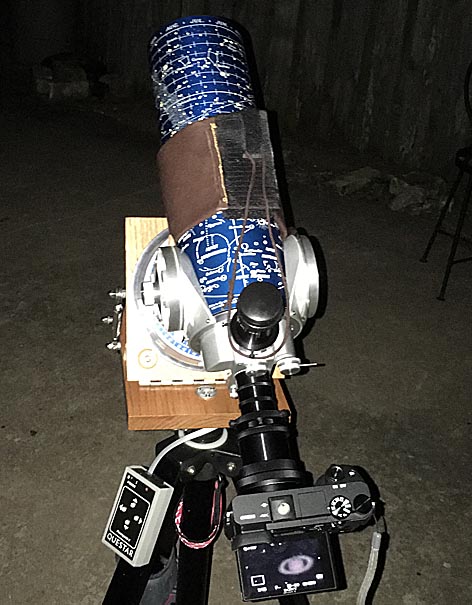- Images
- Blog
- Tools
- Questar
- The Questar telescope
- Questar resource links
- Search for Questar info
- 172mm Focal Reducer
- Afocal adapter for point and shoot camera
- Camera adapter lengths
- Camera adapter threading
- Camera connection
- Camera focusing
- Custom counterweight
- Drift Alignment Joy
- Finder Eyepiece Compatibility
- The Questar Moon 1981
- Questar Powerguide II Battery Life
- Questar Zone, How to Service Videos
- Red Dot finder mount for Questar
- Questar Viewing Table
- Wedge mounts
- White light solar filters comparison
- How to
- Get started in astronomy
- Astro RaspberryPi Camera and kin, the ASIAir and StellarMate
- Blind Smart-phone Equatorial Wedge or GEM Polar Alignment
- Camera phone adapter
- Celestron FirstScope with equatorial tripod mount
- Coat Pocket Astrophotography
- Day-lapse Images of Earthshine on the Crescent Moon
- Dobsonian Carrying Case
- DSO Astrophotography without a Telescope
- DSO imaging without a star tracker
- Estimating image resolution
- Lunar Eclipse Photography
- Moon photography - a dozen ways to shoot the Moon
- Meteor shower photography & planning
- Matching image sensor size to telescope resolution
- Narrow band imaging with color cameras
- Planetary Image Workflow
- Print and Display Astrophotography
- Observing
- Events
- More
- About
- Contact
The Questar telescope
The Questar Telescope
My Questar Standard 3.5" telescope is my favorite observing instrument - small, precise, tough, and easy to use. Questar related information and resources that I've found interesting, useful, and some that I've painfully had to learn myself are found here. Much of this is too arcane for most people. If you are crazy enough to do astrophotography and odd enough to do it with a small scope, you'll find time here well spent. Telescope suppliers often provide no more than a few words description of parts and accessories. I've included lots of photos to clarify what things look like and how they fit together.

Questar history
The Questar is a Maksutov catadioptric telescope. Invented by Dmitri Dmitrievich Maksutov in 1941, it combines a primary mirror with a negative corrector lens to minimize off axis coma and color aberrations present in Newtonian reflectors. Based on the Schmidt Camera design it uses a simpler corrector lens. Lawrence Braymer, after a delay caused by the Korean war, brought the "Mak" to commercial production as the Questar in 1954 in an 89x1280 mm ultra compact long focal length telescope.
A few years later Questar began using John Gregory's improvements with an aspherical secondary mirror on the interior of the corrector lens. With a built in clock drive and its exclusive control box, the Questar is a marvel of precision, robustness, and ease of use. The control box allows finger tip switching between normal telescopic, low power finder, high power magnified Barlow views, and a second axial optical port for photography. With the included small tripod, the entire package weighs less than eight pounds.
This amazing design has been in continuous production for over sixty years. Its quality and usability have won over many fans including Arthur C. Clarke and Wernher von Braun. Johnny Carson made a suggestion that resulted in the built in solar filter for the finder. Stanley Kubrick's questions to Arthur C. Clarke about the Questar led to the collaboration that resulted in the movie 2001. The Questar long distance microscope configuration was used in testing the corrected lenses in the Hubble Space Telescope Wide Field Planetary Imaging Camera 2 in 1993.
The Questar in space
The Questar is known for a series of spaceflight firsts. Early use of the Questar on manned space flights was classified. The first uses of telescopes in space were to look back at the earth for surveillance. This led to concerns about danger to space flights perceived as spying. Because Questars were included as classified military cargo, much of their history remains hidden. Some notable documented uses of the Questar in spaceflight include:
- A Questar configured with a camera was the first powerful telescope sent into space on the Gemini 5 spacecraft in 1964. Pictures of Cape Kennedy taken by the Questar were published in Newsweek in Sept 27, 1965.
- The Questar also flew on Apollo 9 with observations from the Questar reported in the New York Times of March 17, 1969.
- A Questar was in the manifest of the planned Apollo 18 lunar flight, intended for astronomical observations from the surface of the Moon.
- The final pictures of Space Shuttle Columbia STS-107 showing anomalies with the left wing were taken by a 3.5" Questar from Kirtland Air Force base in New Mexico on February 1, 2003.
Questar today
Today the ease of use and legendary optical quality of the Questar makes a great match with the latest camera technology and post processing algorithms. Questars can take images today that required large observatory instruments when the Questar design was new.
How does the hand tooled Questar remain in production after more than 60 years in an age of cheap mass production? Rumors are that it has a fantastic reputation for durability and quality in military and intelligence agencies world-wide. Whatever the reason, I'm thrilled to have the opportunity to use one frequently - over 100 nights last year alone.
Content created: 2016-05-30
Comments
![]() Submit comments or questions about this page.
Submit comments or questions about this page.
By submitting a comment, you agree that: it may be included here in whole or part, attributed to you, and its content is subject to the site wide Creative Commons licensing.


 Wedge mounts
Wedge mounts